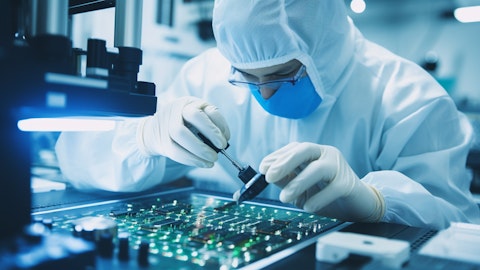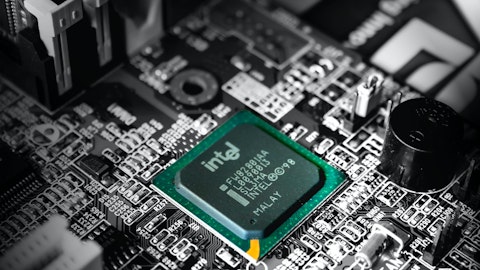Michael Plisinski : I would say it’s tied to AI. So it’s actually, it’s tied to AI very specifically. So we see power semiconductor in the second half growing, advanced nodes is growing. I think the AI is the question because it’s been so strong, it’s ramped so much and I think, is Q3 going to be a little down and then a big surge in Q4, possible. Is that going to get spread around and we see less, these are all the things the customers are working with us on.
Vedvati Shrotre: Got it. Okay. And then I think shifting gears to specialty devices, so every, most of the power semi companies have started to take down their CapEx this year. What’s sort of giving you the confidence that this continues to grow through, I mean, remainder of the year?
Michael Plisinski: Well, that’s an interesting dynamic with process control is that companies, if they don’t have really, really high yields, they can focus on driving more. They can focus on output either by driving more capital spend or in a time like this, they can focus on driving the yields up. And generally driving the yields up means bringing in more sophisticated tools to help identify in the process where yield losses is occurring, and then go and address that. So that’s what we’re seeing right now. And our confidence comes from our backlog and the conversations that we’re having with the customers. So, pretty confident right now in the power semi remaining strong.
Vedvati Shrotre: And then on the advanced notes, what — how is your visibility into the back half of this year?
Michael Plisinski: I’d say it’s the visibility is good. It’s as good as what the customers have. The customers are opening new factories and ramping new lines. And as long as those stay on track, we will see what we see. But those things have moved. So we’ve seen delays announced by some of the — our large customers and we’re optimistic that those delays are all baked in and that there won’t be any more, but I can’t guarantee that. But I can tell you we’re in close contact. We are meeting with them frequently. Working with them frequently, and so at least as soon as they know, I think they’re sharing it with us.
Vedvati Shrotre: Got it. And so, is it fair to assume that it would be kind of a sequential growth every quarter here onwards?
Michael Plisinski: Yes. For advanced nodes, I think that’s pretty fair to say. Yeah.
Vedvati Shrotre: Got it. And then maybe one last one that I’ll squeeze in. On the margin side, you mentioned productivity gains coming around in the back half of this year. Could you kind of help us quantify that? Like what kind of operating expenses and gross margins are we should be looking at?
Michael Plisinski: No, I mean, I think from the gross margin standpoint, I mean we’re projecting to have quarter-over-quarter sequential gross margin improvement. I think as we stated before, our goal is to exit the 2024 back at levels that we’ve seen historically at that revenue that would be that revenue level. As we said before, plans that we have in place. It’s working with our suppliers, it’s working with the plants, and driving through efficiencies. So I would say a thoughtful way to do it would be to plan margin improvement quarter-over-quarter. Operating expenses, the first half of the year it always tends to be higher for us with some of the compensation elements hitting. But again, we do see a slight decline in the back half of the year. So I wouldn’t expect operating expenses to be above the peak of Q2.
Operator: Thank you. Your next question comes from the line of Mark Miller with The Benchmark Company. Please go ahead.
Mark Miller: Hello. Hey, I’m just was wondering, you mentioned that certainly high bandwidth memory’s been playing a major role. Can you estimate in terms of your current backlog, what percentage the backlog is related to high bandwidth memory or AI applications?
Michael Plisinski: I don’t have that in front of me, but I would say it’s a high percentage of the backlog.
Mark Miller: And extrapolating, it’s always dangerous to do this, but extrapolating the next year, do you think that’ll be also a significant, the most, one of the most significant constituents of your backlog? And what about gate-all-around? How will that be increasing as a percent of your backlog?
Michael Plisinski: I don’t worry so much about the backlog because of our turn, the three to six months in the build to forecast, and that kind of thing. So backlog during COVID was a powerful, but prior 20 years backlog for us wasn’t so interesting or, ever that big or of a good indicator of where our business was going to go. But to answer your question, I’d say HBM is I would say interesting. So the concern is, is there a bubble happening? There’s a lot of ramping of capacity for HBM. I think several players are trying to gain share and gain position and the current leader is trying to maintain. So there’s a lot of capacity coming on, and it remains to be seen as, is that excess capacity or does, AI continue to really outstrip projections and other players come in and that HBM memory gets all used up such that we’d see another big ramp.
That part, I don’t know so much. So with that, I would say gate-all-around would be a larger, I would expect gate-all-around, especially towards the second half would be a larger part of our revenue or backlog for next year.
Mark Miller: And then finally, you mentioned an improving margin picture. Is that being driven by newer tools having higher margin profiles such as your Dragonfly with the new sensor?
Michael Plisinski: That’s part of it. It’s also about the supply chain initiatives that we’ve talked about. And a lot of those were expected to start adding, cutting in this year, quarter by quarter, even starting last year, quarter by quarter. So we’re seeing improvements from that too. So it’s twofold and the new products and the new product adoptions, and that’s where advanced nodes growth will start to really have another impact but we’re taking control of our own destiny. We’re also addressing some of the supply chain opportunities we have through the merger.
Mark Miller: Thank you.
Operator: This concludes today’s question and answer session. I would now like to turn the call back to Mike Scheaffer for any additional or closing remarks.
Mike Sheaffer: Thanks again for joining us today. Just a quick reminder for everybody about three upcoming events. First, Onto management will be participating in the B. Riley Annual Institutional Investor Conference in Beverly Hills on May 22nd and 23rd. Next, we’ll be participating in the Stifel Cross Section — Cross Sector Insight Conference being held in Boston on June 4th and 5th. And finally, we’ll be at the Wolfe Research Small and Mid-Cap Conference in New York on June 6th. Our replay of the call today is going to be available on our website approximately 7:30 Eastern Time this evening. I’d like to thank you for your continued interest in Onto Innovation. Rachel, please conclude the call.
Operator: Thank you. This does conclude today’s call. Thank you for your participation. You may now disconnect.
Follow Onto Innovation Inc. (NYSE:ONTO)
Follow Onto Innovation Inc. (NYSE:ONTO)
Receive real-time insider trading and news alerts




